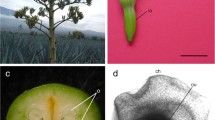Abstract
The embryo and endosperm development inRanalisma rostratum was studied in this paper. The zygote divides by a transverse wall to form basal and apical cells. The larger basal cell undergoes no further division and becomes the basal suspensor cell. The embryo development conforms to the Caryophyllad type. In the mature seed, the embryo is U-shaped and forms the embryonic shoot apex accompanied by one intraseminal leaf. The endosperm development belongs to the Hebolial type. The primary endosperm nucleus (invariably lying in the chalazal part of the embryo sac) divides and forms a large micropylar chamber and a small chalazal chamber. The chalazal endosperm chamber remains uninucleate, and free nuclear divisions occur in the micropylar chamber. Cellularization of the endosperm begins simultaneously from the micropylar and the chalazal ends. The cellularization is related to phragmoplast and cell plate, and does not arise from the free growth wall. Accompanying the embryo development, the endosperm degrades and does not exist in the mature seed. In the proembryo developing stages, the basal suspensor cell and chalazal endosperm cell grow to a considerable size. The nucleus and cytoplasm stain densely. Sometimes, binucleate or trinucleate was observed in both of the two cells. In the laterally concave embryo stage, they begin to degenerate which coincides with the cellularization of the endosperm. They are presumed to participate in the nourishment of the embryo proper in the early stages of embryo development.
Similar content being viewed by others
References
Posluszny U, Charlton W A. Evolution of the helobial flower.Aquat Bot, 1993,44:303–324
Charlton W A. Studies in the Alismataceae: IX. Development of the flower inRanalisma humile.Can J Bot, 1991,51:891–897
Wei H T, Deng M B, Jin N C. Quantitative microcomputorization on grading of rare and endangered plants in China.Acta Botanica Sinica, 1993,35:111–118
Xi X Y. the development ofAllium fistulosum embryo and endosperm.Acta Botanica Sinica, 1987,29: 459–464
Ly T B, Guignard J L. Phylogeny of the helobiae and embryogenic criteria.Phytomorphology, 1979,29: 260–266
Swamy B G L. Embryogenesis inSagittaria sagittaefolia.Phytomorphology, 1980,30:204–212
Dahlgren R M T, Clifford H T, Yeo P F.The Families of the Monocotyledons. Berlin: Springer-Verlag, 1985
Bohdanowicz J.Alisma embryogenesis: the development and ultrastructure of the suspensor.Protoplasma, 1987,137:71–83
Maheshwari P.An Introduction to the Embryology of Angiosperm. New York: McGraw-Hill, 1950
Yeung E C, Clutter M E. Embryogeny ofPhaseolus coccineus: the ultrastructure and development of suspensor.Can J Bot, 1979,57:120–136
Kapoor T, Vijayaraghavan M R. Seed biology ofPotamogeton nodosus Pori.Aquat Bot, 1991,40:261–273
Fieder P L, Jain S K.Conservation Biology. New York: Chapman and Hall, 1992
Author information
Authors and Affiliations
Additional information
Supported by the National Natural Science Foundation of China
Wang Jianbo: born in May. 1964, Ph. D.
Rights and permissions
About this article
Cite this article
Jianbo, W., Jiakuan, C., Rongqian, L. et al. The development of embryo and endosperm inRanalisma rostratum . Wuhan Univ. J. Nat. Sci. 2, 110–114 (1997). https://doi.org/10.1007/BF02834927
Received:
Issue Date:
DOI: https://doi.org/10.1007/BF02834927




